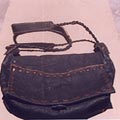The Nepalese community of traditional cobblers and professional tanners, the sarki have been working with leather for centuries. Working with the most elementary of tools, the sarki traditionally hand-craft leather products that include shoes, bags, belts, rugs, horse saddles, knife cases, head straps, and ropes. Their work includes not only the hand-crafting of leather products but also the tanning of the skin of buffaloes, goats, sheep, the high Himalayan cow, and the yak.
PRACTITIONERS
The sarki community of traditional cobblers and professional tanners is one of the most backward and disadvantaged ethnic communities in Nepal. In the year 1422, the then King, Jayasthiti Malla divided the people into castes according to their professions: that is when the caste of the leather workers and tanners – the matangis/sarki caste – was formed.
Until about two decades ago, the sarki community of the Kathmandu Valley hand-crafted shoes. However, the setting up of modern shoe factories has caused the demand for their products to plummet – the sarki community face a bleak and declining future.

In the villages, the sarkis have continued their traditional occupation of crafting shoes and other leather products and curing and tanning leather organically by using locally grown dye-yielding plants. They are proficient in the art of organically tanning leather and use, among other natural ingredients, lime, bark of the kaphal, and the powder obtained from the leaves of the dhaera.
RAW MATERIALS, PROCESS & TECHNIQUE
A wide range of products are crafted and different tanning techniques used by the sarki community who work with a variety of hides.
Deer skin has, since ancient times, had great ritual significance for Hindu religious rites and is indispensable during the upanayan sanskar ritual. Yogis and hermits have traditionally meditated while sitting on deer-skin. The sarkis used deer-skin to produce suet leather in the past. Though now banned by the government, it was earlier used by them to hand-craft yellow shoes lined with fur. These shoes, sewn with bamboo strips, were usually oddly shaped and created a peculiar creaking sound when compressed. Crafted for the hill tribes, they were known as palanchoke, as they were mainly produced in Palanchok, east of the Kathmandu Valley and in the Baglung district in the mid-western region of Nepal (where the hide was also tanned).

As the natural colour of suet leather was pinkish it was dyed a shade of yellow with an extract obtained from the chutro, a tropical plant. The outer layer of the stem of the chutro plant is scraped off with a knife till a yellow layer is reached. This layer is scraped off, collected, and a yellow extract obtained. This extract is repeatedly applied on the suet leather till it acquires a distinct yellow coat.
The ghoral bears a resemblance to the wild grey goat and in the past – before its killing was banned – its hide was processed in a manner similar to deer-hide. Its leather was used for lining shoes.

The thar, a wild animal that resembles a buffalo has skin that is very thick – its hide when processed results in a leather locally called tharko, that is normally made into shoes.
Jharal leather, a variety that resembles tharko, and is thick, strong, and soft, is also used.
The hide of the chauri, a cow whose habitat is the high Himalayan region, is used by the sarkis residing in the Mustang district for making bags, shoes, jackets, and the like.
DUCTS
Besides the already existing traditional range of shoes and bags, a new range of products are being crafted not only to the urban consumer but also to the tourist and export market – these include briefcases, backpacks, pencil cases, belts, shoulder bags, purses, and wallets

TEMPORARY INITIATIVES
Learning from the decline faced by the sarki community in the Kathmandu Valley, an initiative was set up by the Village Leather Training Centre (VLTC), a non-government organisation, to stem the decline in traditional leather-work in the villages. Acting as a facilitator and skill provider, VLTC imparted training on production and marketing to the sarki community. Through this, VLTC not only succeeded in improving the economic standing and self-esteem of the community, but also – through design initiatives – upgraded the quality of the end product. The newly developed products have a natural, rustic texture and improved stitching and finishing. Using traditional natural dyes, the leather is coloured tan, chocolate, and grey-black. The stitching is often done with leather thongs. These products are now being marketed in Nepal and outside the country by Nepalese members of the Free Trade Group.
Gallery
YOUR VIEWS
PRACTITIONERS: INDIA
Access 70,000+ practitioners in 2500+ crafts across India.
BIBLIOGRAPHY
10,000+ listings on arts, crafts, design, heritage, culture etc.
GLOSSARY
Rich and often unfamiliar vocabulary of crafts and textiles.
SHOP at India InCH
Needs to be written.





